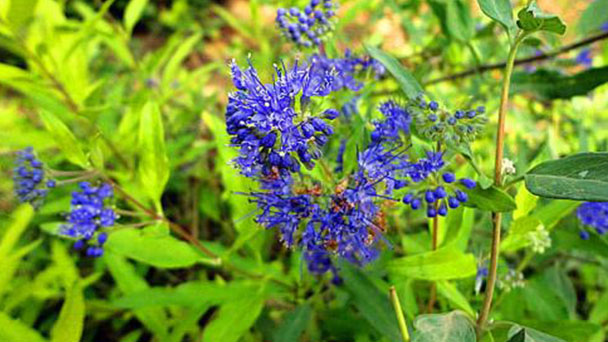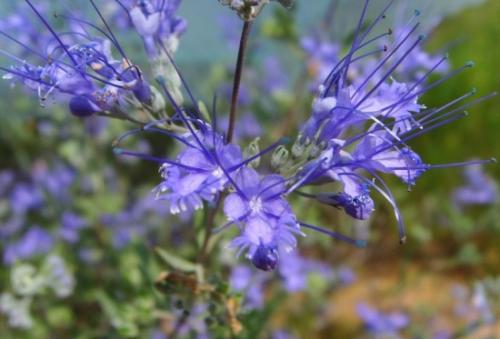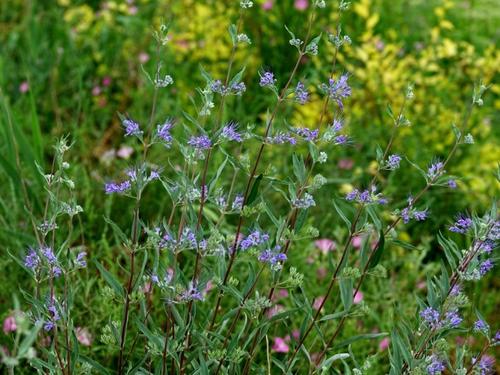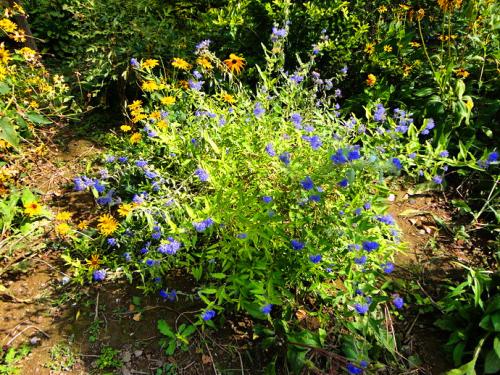Mongolian bluebeard (Caryopteris mongholica) profile
Written by Maggie
Nov 05 2021

Mongolian Bluebeard (Caryopteris mongholica) is a member of the Verbenaceae family.
Mongolian Bluebeard is a deciduous shrub, 1 -- 2m tall. Pollen is red. Drupe is ovoid, densely pubescent. mongolian bluebeard distributes in Inner Mongolia, Gansu, Ningxia, in the elevation of 1000-2400m in the mountains and dry riverbeds and other places. It is also found in Mongolia.
Mongolian Bluebeard picture

Mongolian Bluebeard info
| Botanical Name | Caryopteris mongholica |
| Common Names | Mongolian Bluebeard |
| Plant Type | Shrub |
| Sun | Full Sun, Partial Shade |
| Hardiness Zones | 5 - 9 |
| Flower color | Blue, Purple |
| Native Area | Inner Mongolia |
Morphological characteristics of Mongolian Bluebeard
Branch
Mongolian bluebeard is a small deciduous shrub, often branching from base, 0.3 -- 0 -- 1.5 m tall; Branches are purplish brown, cylindrical, hairy, old branches hair gradually shed.
Leaf
Leaf blade of Mongolian Bluebeard are thick papery, linear-lanceolate or linear-oblong, entire, rarely thinly dentate, 0.8-4 cm long, 2-7 mm wide, surface dark green, slightly hairy, abaxially densely greyish-white hairs; Petiole ca. is 3 mm.
Flowers
Mongolian bluebeard cymes are axillary, without bracts and bracteoles; Calyx is campanulate, ca. 3 mm long, outside densely gray-white tomentose, deep 5-lobed, lobes broadly linear to linear-lanceolate, ca. 1.5 mm long; Corolla is blue-purple, ca. 1 cm long, short hairs on the outside, 5-lobed, larger lobes in the lower lip, fringed with fringes, corolla tubes ca. 5 mm long, with slender pubescent hairs on the throat inside the tubes; Mongolian bluebeard has 4 stamens, several equal length, and style are extended outside the corolla tube; Ovary is oblong, glabrous, stigma 2-lobed.
Fruit
Capsule of Mongolian Bluebeard is elliptic globose, glabrous, petal winged.
The ecological habits of Mongolian Bluebeard
Mongolian Bluebeard grows on arid slopes, dune wilderness, and arid alkaline soils at elevations of 1100 -- 1250 m.
Mongolian Bluebeard grows on gravel hillsides, sandy lands, and valleys in the prairie belt.
The Mongolian Bluebeard type specimens were collected from Inner Mongolia.

The growth habit of Mongolian Bluebeard
Mongolian Bluebeard is a short axed root plant. The root neck is buried in the soil, and the branches can give off adventitious roots under suitable moisture and temperature conditions. Lateral roots are stout, extended horizontally. The taproots begin to branch when they enter the soil at about 10cm, to adapt to the gravel soil habitat, and usually reach about l00cm. After the dormant branches, more in the middle of May around the germination of new leaves, July to August points into the blooming period, from late August to early September, the fruit gradually mature, to late September to early October, with the decrease of temperature began to shed leaves, the plant into the dormant period. Mongolian bluebeard belongs to the xerophyte family. The associated components are common in the stony mountains and gravel slopes of the typical steppe zone, but also brought into the desert steppe zone and the eastern edge of the desert zone. They grow in the sandy land, the bottom of dry riverbed and the rock crevices on the hillside. (Find more fall flowers here.)
The region of Mongolian Bluebeard
Mongolian Bluebeard is grown in Chinese Hebei, Shanxi, Shaanxi, Inner Mongolia and Gansu. In Xilingol League, Wulanchabu League, Bayannaoer League, Yikezhao League, Alxa League also have, but the output is less. (Find more fall plants here.)
Mongolian Bluebeard is distributed in the eastern part of the Mongolian Plateau, Wulanchabu, Ordos, and eastern Alxa. In China, Liaoning Province, Inner Mongolia Autonomous Region, Hebei Province, Shanxi Province, Shaanxi Province, Gansu Province, Qinghai Province, Xinjiang Autonomous Region and other places of distribution; It is also found in Mongolia.
Mongolian bluebeard uses
Forage value
Goats and sheep only feed on its flowers, and horses only feed on its annual branches in winter and spring. Most of Mongolian bluebeard are evaluated as low feeding plants. Mongolian Bluebeard is a kind of carbon and nitrogen type forage with a nutrient ratio of L: 9.4. The flowers, branches and leaves of Mongolian Bluebeard can be used as Mongolian medicine, which has the effect of dispelling cold, dryness and dampness, strengthening stomach, strengthening body and relieving cough. The leaves and flowers also extract aromatic oils.
Medical uses
Mongolian bluebeard can be used as a Chinese medicine for abdominal distension pain, dyspepsia, rheumatic arthralgia, adverse urination, edema.
Landscape use of Mongolian Bluebeard
Mongolian Bluebeard can be cultivated in the garden for ornamental use.

Read Next:
Top 30 Fall Flowers to Plant Beautiful Autumn Flowers
30 Fall Plants for a Beautiful Fall Garden
Latest Updated
- Benefits of Bugleweed - 7 Science-backed Health Benefits
- Bugleweed Dangers & Side Effects - Is It Poisonous?
- How to Plant Evergreen Trees - What You Should Know
- When to Plant Evergreens - Grow Guide for Evergreen Trees
- 12 Wonderful Evergreen Shrubs for Your Garden
- 12 Popular Evergreen Plants with Pictures for Beginners
- When And How To Prune A Lilac Bush Like a Pro
- How to Grow & Care for Lilac Vine (Hardenbergia Violacea)
- Japanese Lilac Tree (Syringa Reticulata) Care & Propagation Guide
- Shumard Oak Pros and Cons - What to Know
Popular Articles
- Winter maintenance of Antirrhinum Majus
- How to Grow Terminalia Mantaly Tree
- How to Grow and Care for Crossostephium Chinense
- How to grow Antirrhinum Majus in spring
- Peristeria Elata (Dove Orchid) Profile: Info & Care Guide
- Underwatered Snake Plant (Sansevieria Trifasciata) - Signs And How To Fix
- How to Care for Brazilian Jasmine Plant (Mandevilla Sanderi)
- How to Grow & Care for Graptopetalum Purple Delight in Summer
- Rosa Chinensis (China Rose): Plant Growing & Care Tips
- How to Care for Baby Sun Rose (Aptenia Cordifolia)